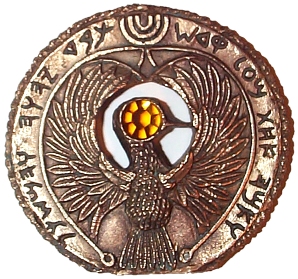NLogan
Member

Thanks to Magnoli for the image, I borrowed from his site
http://www.indyprops.com/index.htm
My question is what language are the markings on the Headpiece inscribed in? I have seen people mention Phoenician, where do they get this reference?
I personally think it should have been engraved with Coptic or Demotic markings.
I don't think that the Hebrews would have designed a Head piece for the Staff of Ra (Egyptian Sun Deity) to use in a map room of Tanis (Egyptian Djanet) unless they were the ones that put it there. If the Hebrews did hide it, why would they pick Tanis? Why would the decorations in the well of the souls be Egyptian instead of more similar to the Temple of Soloman, if the Hebrews were the ones to hide it?
In my opinion the markings on the headpiece would not say "to honor the Hebrew God whose ark this is" if it were made by Hebrews. The sentence structure makes it sound as if the maker of the headpiece does not share the same Hebrew deity.
The Babylonians were the ones who sacked Jerusalem and probably plundered the Ark taking it with them to be later reacquired when Babylonian empire fell to the Islamic conquest. Egypt is an Islamic nation.
To me it would make more sense for it to be in harmony with the map room the Staff of Ra and the Well of Souls (all Egyptian) for the headpiece to be in some form of ancient Egyptian writing or hieroglyphs. The Ark in that setting looks like part of some spoils of war that is well respected or feared, probably because of the deaths of many of the keepers before it was entombed.
I'm pretty sure that Sallah takes Indy to the house of Imam because he is an Egyptian who can still read the "old way". He was not taken to an old Jew.
The old way could be Hieroglyphs, demotic, Coptic or hieratic as opposed to the modern Egyptian Arabic.
Some Phoenician markings that look similar:










If the markings are Phoenician, why would they be on the headpiece, also to honor the Hebrew God? The rest of the Piece looks definitely Egyptian inspired.
